SHARING KNOWLEDGE
At the Dennis & Sisis groundcare seminar
by TurfPro Editor, Laurence Gale MSC, MBPR
Last week I was lucky enough to attend one of the popular seminars held at the prestigious St Albans School’s Woollam Playing Fields, where there were over 250 groundsmen and managers attending.
Last week I was lucky enough to attend one of the popular Dennis / SISIS Groundcare Seminars held at the prestigious St Albans School’s Woollam Playing Fields.
A very oversubscribed day, there were over 250 groundsmen and managers attending.
The popularity of this seminar has grown every year since its inaugural event, held at Uxbridge CC in 2011. Its recipe for success has no doubt been the combination of a number of factors; great venues, having excellent guest speakers and supported by a number of complimentary company partners who are devoted to supplying a fine range of machinery, products and sundries to the sports turf industry – combined with a healthy thirst for knowledge from the attendees.
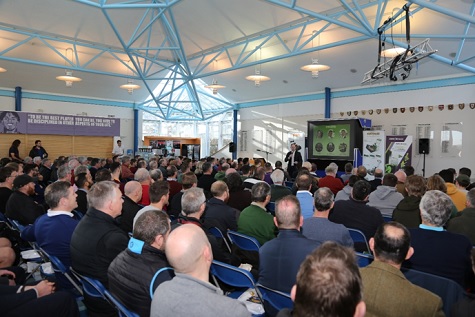
It is the third time St Albans has hosted the event. A big thank you to Ian Smith, Turf Consultant and Steve Ascott, Head Groundsman and his grounds team for preparing the site, which offered exceptional presentation of sports facilities and a superb lunch was provided.
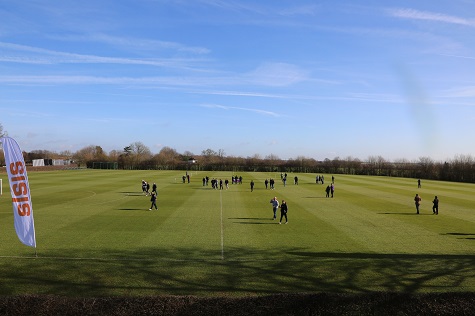
There was not a blade of grass out of place. All the sports pitches looked absolutely fantastic for the time of the year. No doubt the recent spell of fine weather has helped.
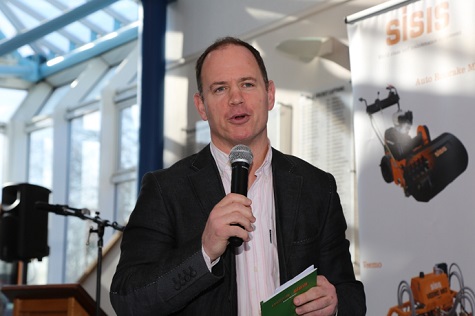
The day began with a welcome by Kyran Bracken MBE former England Rugby International who currently works at St Albans School in the capacity of Elite Sport Development Manager and 1st XV Head Coach. He was keen to praise the work of the grounds staff and commented on the excellent playing surfaces they prepare on a daily basis.

This event is also supported by a number of partners / sponsors who were on hand to give advice and show off their wares throughout the day. In total there where ten companies Bernhards, Consolidate Turf, Cricket World, Garside Sands, Harrod Sport, Headland Amenity, Limagrain, Poweroll, RT Machinery and SIS Grass.
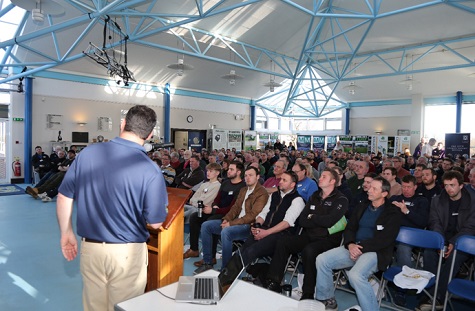
Compare for the day was Robert Jack, area manager for Dennis / SISIS who was hand to keep the day moving. First speaker was Rob Kendle, of ATB (Sports Solutions) who gave an insight on the demands of a modern skilled sports turf contractor with regard to renovating and rejuvenating playing surfaces. He spoke of the specialist equipment and machinery needed to be efficient and precise, showing some examples of the different types of work the company have completed.
Next up was Dr Iain James (TGMS Ltd) who gave an insight into the role of a consultant and the importance of carrying out a feasibility study prior to undertaking any major sports turf project.
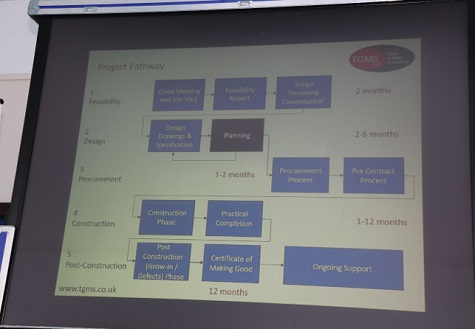
This document is a vital tool to determine the success of the project and ensure it meets all the objectives and aims set out by the client and makes sure appropriate qualified contractors are employed to undertake the work with the aim to keep it within budget and delivered on time.
It was then the turn of the renowned Alex Vickers, consultant (IOG) and one of my old lecturers who taught me at Cranfield University. Alex without doubt, is one of the country’s leading experts on soil and as usual gave an enlightening talk on the principles of soil porosity (drainage).
He then gave some tips on how to identify the different soil types we generally must manage and ways we can improve the soil’s ability to drain by a combination of management and cultural practices.
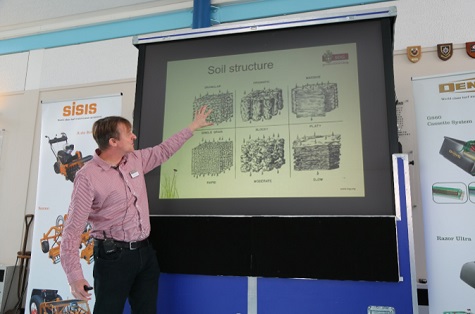
We then broke for lunch, giving the attendees a chance to network with fellow professionals and volunteers plus visit the sponsors stands. One of the most interesting demonstrations during lunch was seeing at first hand the reinforced stitching of some cricket practice net areas by the company SIS Grass.
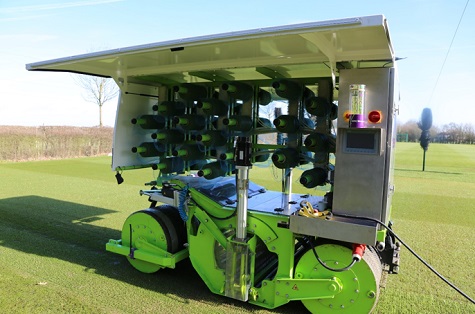
This practice has become quite popular in recent years with many top sporting venues now investing in this technique thus improving the performance and durability of their natural grass playing surfaces.
After lunch we were entertained by two more excellent speakers, first up was Keith Kent, head groundman at Twickenham, who gave a talk about his career to date and introduced the new RFU Groundmen Connect Scheme that involves a support platform for RFU clubs.
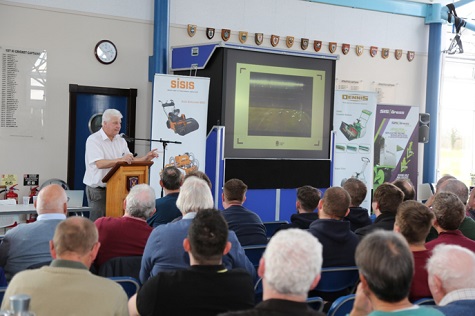
To date well over 1000 groundsmen have signed up to the RFU’s Rugby Groundsmen Connected scheme since its launch in October 2014. Members have a direct communication channel on pitch maintenance issues with Keith Kent and other RFU staff.
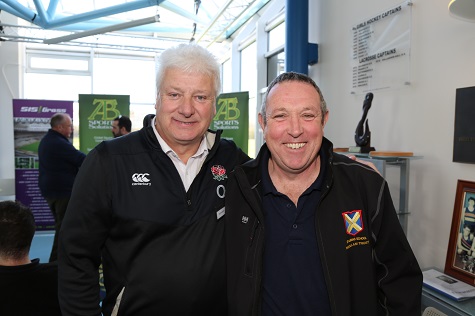
Since its launch Keith has visited literally hundreds of rugby clubs and given valid advice on how to improve their playing surfaces. He also spoke of the new machinery offers that can be obtained via the Groundmen Connect scheme. This includes the chance to purchase a range of equipment such as the SISIS Quadraplay, Outfield Spiker, Iseki Compact Tractor and Wessex Roller Mowers.
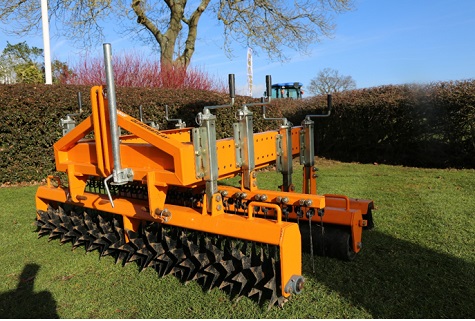
The final speaker of the day was Chris Wood, ECB (Pitch Advisor) who gave an interesting talk on his fifty years working in the industry cumulating in his role of county pitch advisor / inspector for the ECB.
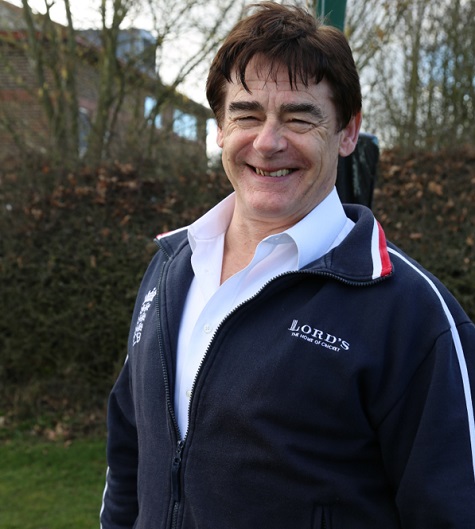
All in all, a very entertaining and thought-provoking day. I would like to take the opportunity of thanking Roger Moore and his staff at Dennis for putting on such a well organised event. It was nice to catch up and talk the talk with so many dedicated turf professionals and colleagues.
As for the weather, we seem to be having a mini spell of exceptional high soil and air temperatures for this time of the year. With temperatures well into double figures, an early flush of growth is being promoted. No doubt there will also be a hive of activity going on, especially with many cricket groundsmen looking to get some early pre-season rolling completed while conditions allow.
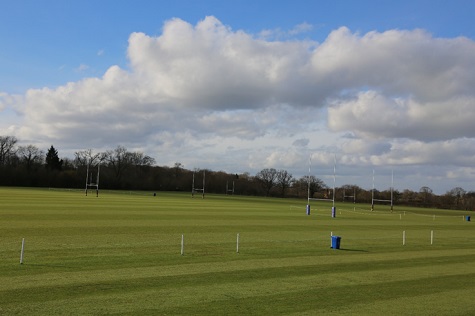
Making best use of the weather has always been a groundsman’s trait. Even with all the latest forecasting software programmes and the use of local weather stations, we still need to react quickly to the ever-changing weather front.
Weather patterns have defiantly changed in recent years. No longer do we get the seasonal trends I experienced when I started in the industry back in the 1970s. Back then we could expect the wintery weather to last several weeks. We would then have a decent spell of spring weather, April showers and then need to cope with a summer of hot, dry weather.
How times have changed. However, we now have a fine array of machinery, equipment and scientific knowledge to aid the turf professional, to help them cope and work with these weather fluctuations.
I’m not sure of how long this favourable weather will last?The key is to make the most of it and get any appropriate work done - particularly some beneficial aeration work - while the weather lasts.
 |
|
 |  |
BIGGA VOLUNTEER SUPPORT TEAM ANNOUNCED
For the 148th Open Championship at Royal Portrush
Heading to Northern Ireland for the first time, the BIGGA members will assist with maintaining bunker presentation throughout the duration of the tournament.
BIGGA has unveiled the line-up for the volunteer support team that will be heading to Northern Ireland for the first time ever as The Open Championship tales place at Royal Portrush Golf Club.
The BIGGA members who have gained a place on the team are given unprecedented access to 'golf’s greatest championship' and they will assist with maintaining bunker presentation throughout the duration of the tournament.

Angus Roberts and Dale Housden joined the BIGGA Open Volunteer Support Team in 2018
Each year The R&A requests BIGGA’s assistance with the championship.
The 62 bunkers that will be in play is the lowest total of any current Open venue, but the team members will hope players stay out of Royal Portrush’s famous Big Nellie bunker, measuring a massive 25-feet high, which has been recreated on the 7th hole.
Every Full BIGGA greenkeeper member is eligible to apply for a place on the team, but with The Open being hosted on Irish shores for the first time since 1951, there is a large contingent of Irish and Northern Irish members who have joined the team.
Among them is Aaron Small, course manager at Belvoir Park in Belfast, who will be joining the support team for the first time in 10 years.
Aaron, 42, said: “The Open is brilliant for Northerm Ireland in general, but as a golfer and a greenkeeper, it’s the ultimate. When I found out I was on the team I was absolutely elated, I couldn’t be happier."
Members of the support team may also be called upon at short notice to assist Course Manager Graeme Beatt and his team with early morning preparation work and divoting duties. With early tee times and golf being played until nightfall, the week is intense and physically-demanding. But it’s also an opportunity to get inside the ropes at this once-in-a-generation tournament.
BIGGA Chief Executive Officer Jim Croxton said, “Excitement is building for The Open at Royal Portrush and having spoken to Course Manager Graeme Beatt, I know he’s looking forward to welcoming the BIGGA members to the course for the duration of the event.
“Royal Portrush is going to be a stern challenge for the world’s best golfers and I’m delighted that BIGGA members have played such a vital role in preparing the course. Graeme and his team have been working hard for a number of years to ensure the Dunluce is in world class condition, with a lot of restructuring and course improvement taking place. The pressure to perform will never be higher, but they’re a fantastic example of what a talented, passionate team can achieve.
“The Open is a long week and everyone works extremely hard, but the rewards are incredible. Everyone at BIGGA is looking forward to giving our all to make sure the 148th Open is a tremendous success.”
The BIGGA Volunteer Open Support Team will be provided with accommodation, food, refeshments and uniform for the event.
The 148th Open Championship takes place from 18 to 21 July 2019.
Here are the BIGGA members who will be assisting the home greenkeeping team for the duration of the event:
Adam Baldwin, Lilley Brook; Craig Berry, St Andrews Links Trust; Sam Bethell, Chipstead; Alex Brougham, Trentham Park; Sophie Bulpitt, The Berkshire; David Byron, Thorndon Park; Gary Corlett, Mount Murray; Joe Curtis, Gloucester; James Dawson, Oulton Hall; James Devoy, Donaghadee; Allan Donlevy, Abbeydale; Anthony Duffield, Ham Manor; Josh Dunn, Bramcote Waters; Nicholas Edwards, Remedy Oak; David Feeney, Prestwick; David Fellows, Cocks Moors Woods; David Forbes, Faughan Valley; Phil Hellier, Axe Cliff; Graham Ives, Louth; Richard Jenkinson, Golf House Clb (Elie); Rodney McKay, Galgorm Castle; Ronan McKeown, Golf Club Montgomerie Links; Scott McTaggart, Ralston; Glen Mlotek, Shiskine; Ryan Neale, Bromsgrove; Ian Nichols, Orsett; Daniel Patten, The Mere; Oliver Pennington, Les Ormes; Richard Ponsford, Clevedon; Chris Powell, St Clements; Leigh Powell, Windlesham; Kevin Ravier, Golf de Lavaux; Peter Roberts, Belvoir Park; Graeme Roberts, Swinley Forest; Peter Robinson, Slieve Russell; Andrew Ross, Maxstoke Park; Aaron Small, Belvoir Park; Phillip Snellin, Donaghadee; Ollie Tanton, Royal North Devon; Mark Thompson, Galgorm Castle; Sean Tully, Meadow Club; Daniel Tyrrell, Gathurst; Andy Unwin, Birley Wood; Darryl Walker, Portstewart; Paul Walton, Hexham; Richard Whyman, Burnham & Berrow; Adam Young, The Players Club.
 |  |
S&C SLATTER ACQUIRES WHITE HORSE CONTRACTORS
Becomes a member of The Slatter Group
White Horse Contractors will operate from the Group Head Office in Enborne, Newbury as an autonomous business under the guidance of newly appointed md David Smith and technical director James Welsh.
S&C Slatter has announced the acquisition of White Horse Contractors which becomes a member of The Slatter Group.
White Horse Contractors was established in 1957 by Arnold Binning. Since then it has grown into one of the leading providers of natural turf sports facilities, land drainage, water engineering, landscaping and civil engineering projects.
As a well-established family business, S&C Slatter are experts in the design and construction of sports facilities including artificial and natural pitches, multi-use games areas (MUGAs), hard and soft landscaping. The Surfacing & Civils division is also successful in securing an increasing share in the infrastructure sector – car parks, roadways, hard standings.
White Horse Contractors will operate from the Group Head Office in Enborne, Newbury as an autonomous business under the guidance of newly appointed managing director David Smith and Technical Director James Welsh.
With this addition, The Slatter Group say they can offer an unrivalled scope of services to a broad reach of clients within the sports grounds, amenity, leisure, agricultural and equestrian sectors. They believe the knowledge base and resource that White Horse Contractors brings to the Group complements the skills, technology and experience in artificial surfacing, civil engineering and project development accessible from the existing specialist divisions of S&C Slatter.
David Slatter, who oversees the operations of all Group companies, said, "When I first took over the business from my Father, we provided sub-contract services for White Horse Contractors on their bigger projects. For me they were always the ‘Gold Standard’ which I was aiming to emulate and to this end I saw a perfect opportunity to approach the Directors of White Horse Contractors. To be able to bring their expertise and resource to our family business is a dream come true for me."
James Binning is the third generation of the Binning family to chair White Horse Contractors and says, "I am delighted that we have found another family business which can take White Horse Contractors to new heights and that shares our company ethos and family values. Many of our staff have worked with us for decades and it is important to us that the business continues to be run in the same style as it has for the last 60 years."
However, the Binning family association with the industry will not cease as White Horse Contractors’ workshop and plant will continue to grow and thrive under a new name, Muddy Plat Hire Ltd, providing specialist plant hire services to The Slatter Group and the industry at large.
 |  |
WARWICK RACECOURSE DELIVERS
In challenging conditions
Maintaining a strong sward over a wet winter period is a headache for any turf manager, but for head groundsman at Warwick Racecourse, Guy Woodward, that challenge is further exacerbated by the impact of horses.
Maintaining a strong, healthy and dense sward over a wet winter period is a headache for any turf manager, but for head groundsman at Warwick Racecourse Guy Woodward, that challenge is further exacerbated by the impact of horses pounding the flats and taking the jumps.
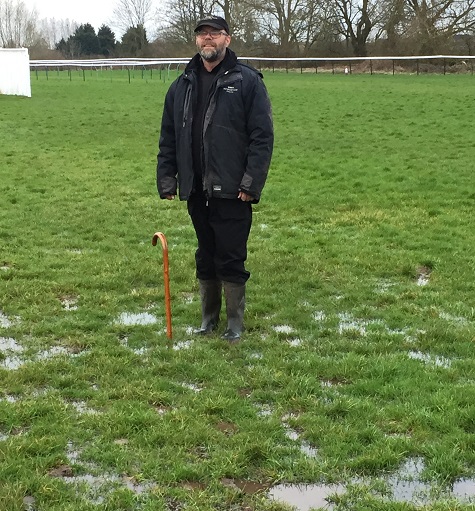
Guy Woodward
For Guy to achieve any germination and recovery, he says he needs a seed mixture that can perform under some of the most challenging growing conditions. Guy has turned to new tetraploid technology in the Masterline ProMaster 79 mixture, to deliver that.
Since the decision was made in 2014 to covert to an all-jumps race programme, Warwick Racecourse has established itself as one of the leading, small National Hunt racing courses. “Our season runs from the end of September to the end of May, with fixtures right through the winter,” explains Guy who heads up a grounds team of four.
“In a normal season we will backfill with a combination of soil and seed after every meet, as well as moving the hurdles to give the horses fresh ground and helping us spread the wear and maintain coverage.
“When it comes to making my decision on seed mixtures, the key criteria is a seed that can germinate late and early in the year. I spoke with Ian Barnett of DLF Seeds and he recommended the ProMaster 79 mixture from Masterline.”

Warwick home straight
PM79 contains 50% Double 4Turf tetraploid ryegrass, in combination with 20% Platinum and 30% Esquire diploid ryegrass to offer germination through the tough winter period.
“Though we don’t expect to achieve masses of growth, if we overseed whilst carrying out our post-meet repairs means we know the seed is there when the time is right, and if we do get any peaks in temperature, we may get some growth.”
Last year, the months of early rainfall, which left areas of the course badly waterlogged, were followed by warmer temperatures which saw the PM79 mixture once again working well.
“We achieved the germination I look for and all of the overseeding we did through the winter is showing on the racing lines. It’s thanks to DLF that we seem to have a mixture that’s working for us and our requirements, helping to maintain strong coverage even when mother nature does her best to stop us!”
 |  |
TORO TO BUY MAKER OF DITCH WITCH
$700m purchase of Charles Machine Works
The Toro Company in the US has announced that it is to acquire The Charles Machine Works, Inc, which will see the company entering into the underground construction market.
The Toro Company in the US has announced that it has entered into a definitive agreement to acquire The Charles Machine Works, Inc, manufacturer of the well-known Ditch Witch brand, which will see them entering into the underground construction market.
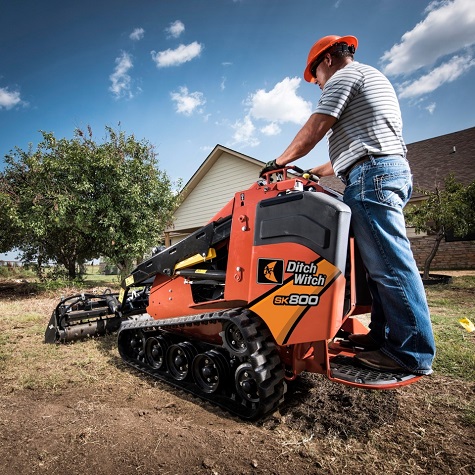
The purchase of the Oklahoma-based company is reported to be for $700 million in cash, subject to certain adjustments set forth in the definitive agreement. The transaction is subject to regulatory approvals and other customary closing conditions and is currently anticipated to close before the end of Toro’s fiscal 2019 third quarter.
Charles Machine Works designs, manufactures and sells a range of products to cover the full life-cycle of underground pipe and cable, including horizontal directional drills, walk and ride trenchers, utility loaders, vacuum excavators, asset locators, pipe rehabilitation solutions and after-market tools.
Richard M. Olson, Toro’s chairman and chief executive officer said in an official statement, “The addition of Charles Machine Works will further strengthen our portfolio of market-leading brands supported by talented employees, a commitment to innovation, a best-in-class dealer network and long-standing customer relationships.
"As an organisation, Charles Machine Works aligns well with and will contribute to our own strategic priorities of profitable growth, operational excellence and empowering people. The company expands our business in a meaningful way in an adjacent category we know well through our own specialty construction business and in a market that is attractive given the potential for growth in addressing both aging infrastructure that is currently in place and new infrastructure that will be needed to support next generation technologies like 5G.”
Rick Johnson, Charles Machine Works chief executive officer, added, "From developing the world’s first service line trencher in Perry, Oklahoma, to today’s robust Ditch Witch dealer network, our family of companies is well-positioned to join The Toro Company’s family of brands. We look forward to building upon our founder’s legacy of best-in-class offerings in the expanding underground construction market.”
 |  |
ALLETT LAUNCH BATTERY POWERED CYLINDER MOWERS
First time lithium-ion offering
Until now, Allett’s mowers have traditionally been powered by petrol, with some products also available as electric models.
Allett have been producing cylinder mowers for more than 50 years and until now, their mowers have traditionally been powered by petrol, with some products also available as electric models.
The company has now launched lithium-ion models to its range with its Liberty battery powered mowers.
Discussing the new additions, managing director of Allett Lawnmowers, Austin Jarrett said, “At Allett we are incredibly proud of our roots and the tradition associated with our lawnmowers, however that needn’t mean we don’t evolve our offering.
"Battery powered products have significant benefits - not just for the environment but also for users. They are incredibly convenient and offer significant power without compromising on the cut quality that our machines are famed for.”
Available in three different sizes, 30cm, 35cm and 43cm, the Liberty mowers combine the classic 5 or 6 blade cartridge cylinder system with modern lithium-ion technology. The self-propelled mowers are described as being suitable for all small to medium-sized gardens and all feature a rear roller for striping.
The Liberty 30 push mower is the entry level option for small to medium gardens featuring six speed options. A fully charged battery allows for up to 400m² of lawn to be mowed.
Also suited for small to medium gardens, but offering more features, is the mid-range Liberty 35. Powered by a 40V Lithium-Ion battery, it is a 14″ self-propelled cylinder mower equipped with a five-bladed cutting cylinder. This mower is capable of delivering 88 cuts per metre.
The final mower is the Liberty 43 which is the top of the range model. With a self-propelled feature, steel front roller and double section rear roller with geared differential it also benefits from a 62 litre grass box collection.
 |  |
STRONG FAIRWAYS ACHIEVED
At Abridge Golf Club
In what was a challenging year for greenkeepers across the country, course manager at Abridge, Geoff Smith, says he had no complaints with the way his course emerged from the hot weather.
In what was a challenging year for greenkeepers across the country, course manager at Abridge Golf Club, Geoff Smith, says he had no complaints with the way the course emerged from the prolonged period of hot weather.

The fairways, in particular he says, came out looking better than ever, which he puts down to the timely installation of a new Perrot irrigation system, and his tried and tested nutritional programme from Headland Amenity.
Geoff joined Abridge, a Regional Open Qualifier 2009-2013, as an assistant greenkeeper 17 years ago, on the back of learning his trade at The London Golf Club.
“When I took charge 12 years ago in the autumn of 2006, I found out within my first 3 months at the helm that we were going to be hosting a large national tournament in the summer of 2007, which was a daunting challenge to say the least! I decided to call on the expertise of some trusted industry contacts - one of whom was Claire Harley of Headland Amenity.
“All those years ago she recommended we apply Multigreen 28-3-15 temperature-controlled release fertiliser on the fairways, a programme we still follow to this day.
“Abridge can be a bit of a grass factory but with the controlled release of Multigreen, we get a consistent, healthy growth on the fairways that continues for months. Last year was a great test for our nutritional programme and we’ve emerged with flying colours!”
Geoff applies Multigreen once a year, and compliments this with a tank mix of TriCure and Elevate Fe, applied in September/October, to help in the management of Dollar Spot - another recommendation from Claire.
Geoff adds, “I have a great working relationship with Claire and know she’s always on the end of the phone if I need help or guidance. Undeniably, the Multigreen feeds, together with a verti-drain and scarification programme, has helped me to produce fairways that our visitors and members describe as carpets! They love to play on them and that’s really what counts.”
 |  |
DEERE REPORTS Q1 SALES OF $498 MILLION
Net sales up 16% to $6.94 billion
Deere & Co. have reported net income of $498.5 million for the first quarter ended January 27th 2019 compared with a net loss of $535.1 million for the quarter ended January 28th 2018.
Deere & Co. have reported net income of $498.5 million for the first quarter ended January 27th 2019 compared with a net loss of $535.1 million for the quarter ended January 28th 2018.
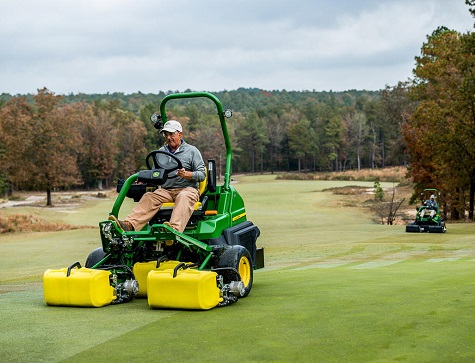
Affecting first quarter 2018 results were charges to the provision for income taxes due to U.S. tax reform legislation. Without these tax reform charges, first-quarter 2018 net income results would have been $442.1 million.
The manufacturer has also reported that net sales were up 16% to $6.94 billion. Forecast for 2019 calls for net income of approximately $3.6 billion on sales gain of about 7%.
In a statement, Samuel R. Allen, chairman and chief executive officer said, “Although Deere has continued to make solid progress on a number of fronts and reported higher earnings for the quarter, our results were hurt by higher costs for raw materials and logistics as well by customer concerns over tariffs and trade policies.
"These latter issues have weighed on market sentiment and caused farmers to become more cautious about making major purchases. At the same time, sales of John Deere construction and forestry machinery have continued at a strong pace. We believe cost pressures should abate as the year progresses and are hopeful we will soon have more clarity around trade issues.
"As a result, we remain cautiously optimistic about our prospects for the year ahead.”
 |
|
 |  |
LOOKING FOR A CAREER WITH A BRIGHT FUTURE?
John Deere dealerships across the country offer exciting opportunities working with the latest technology
We are recruiting technicians, parts personnel, parts & service apprentices and sales staff.
We’re a company that values practical skills, problem solving, team work and initiative. We are recruiting
- technicians
- parts personnel
- parts & service apprentices
- sales staff.
Visit our website www.JohnDeere.co.uk for details and how to apply.
Email us 31enquiries@johndeere.com
ADVERTISE YOUR JOBS HERE
Amazing success rates!
Advertise your recruitment needs on TurfPro Weekly Briefing and reach our targeted audience of recipients every week.
Contact Nikki Harrison for details - 01491 837117
|
 |  |
 |  |
 |  |
 |  |
 |  |
ELIZABETHAN RESTORATION
At Castle Bromwich Hall Gardens
by TurfPro Editor, Laurence Gale MSC, MBPR
An important example of English Formal Garden design, a small gem of a find in the middle of the urban sprawl of Birmingham, is being restored to its former glory.
As a practicing horticulturalist, I gained a lot of my knowledge and experience from visiting long established formal gardens and seeing at first hand the wonderful array of plant species we have managed and maintained over the last two hundred years.

During my early career I was fortunate to have had the chance to work as a parks apprentice and propagator for Birmingham Parks Department, working in some premier parks, such as Kings Heath and Cannon Hill Park. Happy days they were too.
We in this country are spoiled with the vast array of established gardens we can visit. Traditionally many were founded by the popularity of the Victorians, who in the early 1900s began establishing the many formal parks and gardens we are able to enjoy today.
However, much of this plant knowledge and enthusiasm for plant collections began much earlier with many dating back to the Elizabethan times. One such garden I recently visited is the little known, Castle Bromich Hall Gardens a small gem of a find in the middle of the urban sprawl of Birmingham.
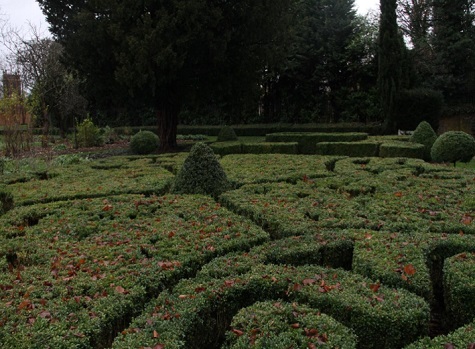
Castle Bromwich Hall Gardens are an important example of English Formal Garden design. Being 10 acres in total, 8 acres within the walls and 2 acres of outer garden now restored to how they were when completed in approximately 1740, makes them a unique item of British heritage. Many formal gardens were swept away from early in the 18th century when the English Landscape (‘romantic’) style of garden layout became fashionable.
Later in the 18th century this style was popularised by Lancelot (‘Capability’) Brown. Castle Bromwich’s Gardens are certainly one of the largest of these walled Gardens remaining in the United Kingdom and with their terraces and surrounding walls, they were created by some of the most outstanding artists, craftsmen and designers of that time. They make an important contribution to our cultural heritage and garden history. However, the passage of time and extensive vandalism reduced them to a shadow of what they once were.
Following a report in 1982, Castle Bromwich Hall Gardens Trust was established in 1985 with one of its objectives being to restore them to their state in the mid 18th century. (As vividly portrayed in Henry Beighton’s Prospect (1726) and published in William Dugdale's "Antiquities of Warwickshire" 1730).
Originally laid out in the 17th and 18th centuries, the formal design has survived until today. The trust has restored the gardens to the appearance of 1740-1760 when the Bridgeman family, the Earls of Bradford occupied the hall. The family moved to Weston Park in 1762 and rented out the hall. Countess Ida reoccupied it in 1869 keeping the layout intact. She died in 1936 and the hall was then used by various commercial interests with the gardens falling into disrepair.

Following the initial restoration the Trust are now in the process of reassessing the layout of the structural plants. They have recently completed some bulb planting to enhance the gardens spring display.
The Trust now employs a small team of key people who between them manage, run and promote the gardens trying to attract as many visitors as possible.
- Ann Brookman - Education Officer has been in post since January 2010. She started working with community groups as part of the Neighbourhood Agenda 21 Scheme for a local authority. Some of this involved environmental improvement schemes and work with Friends groups. At the same time she was volunteering with the National Trust and developed an interest in garden history. Her current post combines her love of horticulture and history with the opportunity of sharing it with visitors and school groups.
- Denise Seckham - Lead Gardener has been in post since February 2018. Always a keen gardener, especially after a chance encounter with Alan Titchmarsh. After attending several horticultural courses at Pershore College, she soon found a job working at the Birmingham Botanical Gardens, followed by a stint of 8 years at Stowe a National trust Property.
- Glynis Powell - General manager has been in post since March 2015. An Art Historian by education she has spent the last 30 years, firstly in media, tv and community training and then in advising museums and heritage sites across everything from audience development, through fundraising to social media marketing.
- Tanya Upton - Gardener. Tanya has worked at Castle Bromwich Hall Gardens for nearly a year, after doing a WRAGS placement for one year and previously volunteering at the gardens in her spare time. After completing her RHS Level 2 qualification, she now studying towards the RHS Level 3 qualification.
Between them they have a keen interest to continue the development and enhancement of the gardens. In total there are five paid staff (General Manager, Office and Volunteer Manager, Part-time Education Officer, Full time Gardener, Gardener (4 days) plus 1 Wrags Placement Gardener (funded for 2 days).
As for machinery and equipment they have the essential tools such as a ride on lawnmower, strimmer, hedge trimmers, rotary self-propelled lawnmower, hover mower, rotavator and compact tractor to keep the gardens maintained.
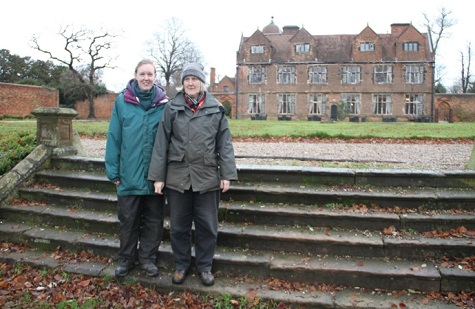
After a brief introduction to all the staff, I was duly shown around the gardens by Ann and Tanya who described the work here at the gardens as always varied, with a range of planting situations, from the herbaceous borders, lawns, wildernesses, vegetable garden, orchards, and wildlife areas.
“There is always a lot of weeds to keep on top of, and we try to hand-weed and use woodchip mulches where possible in the large wilderness beds,” said Ann. “The lawns and grass paths are mown weekly during the high growing season (May-September) and fortnightly in spring and autumn.
“We use the ride-on mower with a mulching deck for the larger areas of grass such as the Archery Lawn and outer orchard. In the outer orchard, which is outside of the main walled garden, it is a bit less formal and we allow areas of grass to grow long in the summer for the benefit of wildlife, cutting ribbons of grass short into informal paths to allow people to walk around. After the wildflowers have set seed and at the end of the summer season we mow the whole lot back for the winter.

“For the paths and smaller areas we use the petrol pedestrian mowers with rear roller. For the large paddocks in the car parking area we have a tractor with a mower attachment to use over the summer and before events when the extra car parking space is needed.”
As there are so many grass paths in the gardens there is a lot of edging to be done, which is done with hand edging shears to keep a crisp finish and line. “In autumn,” explained Ann, “we collect some leaves to create leaf-mould, but also mow over some areas and let nature break the resulting small bits down further.
“We have had a problem with chafer grubs this year on the Archery Lawn, and resulting damage from the crows and magpies pulling the grass up to feed on them. We are currently trying to renovate the affected areas by removing the damaged grass and raking the ground over. In spring we will try and reseed it, and if unsuccessful and funds allow, we may re-turf it.”
As for visitors the gardens get in the region of 10,000 per year - made up of a variety of users: casual visitors, schools and family groups and event visitors. With the main restoration work completed, it is now a case of improving the visitor experience and ensuring the sustainability of the gardens.
So next time you want to see something different and get a feel how the Elizabethans lived and enjoyed their gardens, take the opportunity to visit these wonderful gardens.
 |
|
|
|